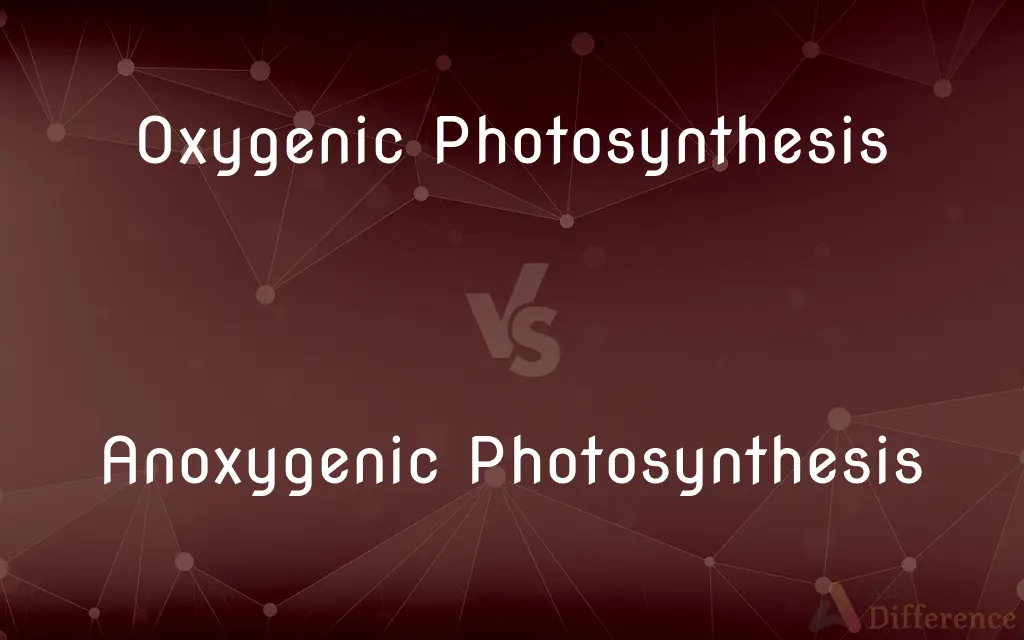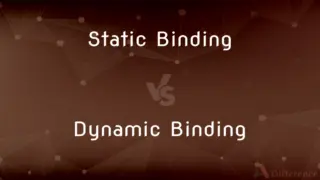Oxygenic Photosynthesis vs. Anoxygenic Photosynthesis — What's the Difference?
By Tayyaba Rehman — Published on December 13, 2023
Oxygenic photosynthesis produces oxygen and utilizes water as an electron donor, while anoxygenic photosynthesis doesn't produce oxygen and uses other compounds as electron donors.

Difference Between Oxygenic Photosynthesis and Anoxygenic Photosynthesis
Table of Contents
ADVERTISEMENT
Key Differences
Oxygenic photosynthesis and anoxygenic photosynthesis are two distinct processes that photosynthetic organisms use to convert light energy into chemical energy. Oxygenic photosynthesis is the type most are familiar with, as it's carried out by plants, algae, and cyanobacteria. In this process, water is used as the electron donor, and oxygen is released as a byproduct.
Anoxygenic photosynthesis, conversely, doesn't produce oxygen. This process is primarily performed by certain bacteria, like purple sulfur bacteria and green sulfur bacteria. Instead of water, these bacteria use other compounds, such as hydrogen sulfide or other organic compounds, as their electron donors. As a result, oxygen isn't released during the photosynthetic process.
Another distinction between oxygenic photosynthesis and anoxygenic photosynthesis is the location within the cell where they occur. Oxygenic photosynthesis typically takes place in chloroplasts (in plants and algae) or in the thylakoid membranes of cyanobacteria. Anoxygenic photosynthesis occurs in the plasma membranes of bacteria, formed into folds called chromatophores.
Both processes, however, aim to capture light energy and convert it into a usable form for the organism. In oxygenic photosynthesis, the end products are oxygen, ATP, and NADPH. In anoxygenic photosynthesis, the end products vary based on the electron donor but typically include molecules like sulfur instead of oxygen.
Despite the differences, both oxygenic photosynthesis and anoxygenic photosynthesis play crucial roles in the Earth's ecosystems. Oxygenic photosynthesis contributes to the planet's oxygen levels, making it possible for aerobic organisms to thrive. Anoxygenic photosynthesis, on the other hand, plays a role in various biogeochemical cycles, such as the sulfur cycle.
ADVERTISEMENT
Comparison Chart
Oxygen Production
Produces oxygen
Does not produce oxygen
Electron Donor
Water
Compounds like hydrogen sulfide
Location in Cells
Chloroplasts or thylakoid membranes
Plasma membranes (chromatophores)
Organisms Performing the Process
Plants, algae, cyanobacteria
Certain bacteria (e.g., purple sulfur bacteria)
End Products
Oxygen, ATP, NADPH
Varies (often sulfur compounds)
Compare with Definitions
Oxygenic Photosynthesis
Energy conversion releasing O2, ATP, and NADPH.
Through oxygenic photosynthesis, plants convert sunlight into usable energy forms.
Anoxygenic Photosynthesis
Process using electron donors other than water.
Anoxygenic photosynthesis can use hydrogen sulfide as an electron source.
Oxygenic Photosynthesis
Photosynthesis found in plants, algae, and cyanobacteria.
Oxygenic photosynthesis is responsible for the majority of Earth's oxygen production.
Anoxygenic Photosynthesis
Alternative photosynthetic method in certain environments.
Anoxygenic photosynthesis is common in environments lacking oxygen, like deep-sea vents.
Oxygenic Photosynthesis
Process using water as an electron donor.
Oxygenic photosynthesis relies on water to drive the photosynthetic reactions.
Anoxygenic Photosynthesis
Photosynthesis that doesn't produce oxygen.
Purple sulfur bacteria perform anoxygenic photosynthesis, releasing no oxygen.
Oxygenic Photosynthesis
Primary method of photosynthesis supporting aerobic life.
Oxygenic photosynthesis has shaped the evolution of life on Earth.
Anoxygenic Photosynthesis
Photosynthesis primarily in specific bacteria.
Green sulfur bacteria are known for their unique anoxygenic photosynthesis.
Oxygenic Photosynthesis
Photosynthesis producing oxygen as a byproduct.
Most plants undergo oxygenic photosynthesis to release oxygen.
Anoxygenic Photosynthesis
Energy conversion process producing varied byproducts.
Depending on the electron donor, anoxygenic photosynthesis might produce sulfur compounds.
Common Curiosities
Where does anoxygenic photosynthesis occur?
It occurs in the plasma membranes of certain bacteria.
What does oxygenic photosynthesis produce?
Oxygenic photosynthesis produces oxygen, ATP, and NADPH.
Which photosynthesis uses water as an electron donor?
Oxygenic photosynthesis uses water as its electron donor.
Why is oxygenic photosynthesis crucial for Earth?
It's responsible for the majority of the planet's oxygen production.
Do any eukaryotes perform anoxygenic photosynthesis?
It's primarily seen in certain bacteria, so it's rare in eukaryotes.
Is oxygen released in anoxygenic photosynthesis?
No, anoxygenic photosynthesis doesn't release oxygen.
What organisms perform oxygenic photosynthesis?
Plants, algae, and cyanobacteria perform oxygenic photosynthesis.
Is oxygenic photosynthesis more common than anoxygenic?
Oxygenic photosynthesis is more widespread due to plants and algae.
How does oxygenic photosynthesis influence ecosystems?
It supports aerobic life and influences various biogeochemical cycles.
Can anoxygenic photosynthesis occur in the presence of oxygen?
Often, it occurs in environments with low or no oxygen.
What are common byproducts of anoxygenic photosynthesis?
Byproducts vary but often include compounds like sulfur.
How do organisms benefit from oxygenic photosynthesis?
They obtain energy in the form of ATP and NADPH.
Are there multiple types of anoxygenic photosynthesis?
Yes, depending on the electron donor used.
Why don't anoxygenic photosynthetic organisms release oxygen?
They use electron donors other than water, so oxygen isn't produced.
Which photosynthesis is older evolutionarily?
Anoxygenic photosynthesis is believed to be older than oxygenic photosynthesis.
Share Your Discovery

Previous Comparison
Propylene Glycol vs. Glycerin
Next Comparison
Static Binding vs. Dynamic BindingAuthor Spotlight
Written by
Tayyaba RehmanTayyaba Rehman is a distinguished writer, currently serving as a primary contributor to askdifference.com. As a researcher in semantics and etymology, Tayyaba's passion for the complexity of languages and their distinctions has found a perfect home on the platform. Tayyaba delves into the intricacies of language, distinguishing between commonly confused words and phrases, thereby providing clarity for readers worldwide.












































